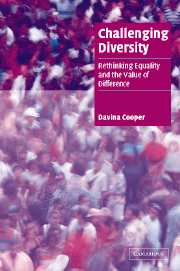Book contents
- Frontmatter
- Contents
- Acknowledgments
- 1 Introduction: mapping the terrain
- 2 Diversity politics: beyond a pluralism without limits
- 3 From blokes to smokes: theorising the difference
- 4 Towards equality of power
- 5 Normative encounters: the politics of same-sex spousal equality
- 6 Getting in the way: the social power of nuisance
- 7 Oppositional routines: the problem of embedding change
- 8 Safeguarding community pathways: ‘possibly the happiest school in the world’ and other porous places
- 9 Diversity through equality
- Bibliography
- Index
- Cambridge Cultural Social Studies
4 - Towards equality of power
Published online by Cambridge University Press: 22 September 2009
- Frontmatter
- Contents
- Acknowledgments
- 1 Introduction: mapping the terrain
- 2 Diversity politics: beyond a pluralism without limits
- 3 From blokes to smokes: theorising the difference
- 4 Towards equality of power
- 5 Normative encounters: the politics of same-sex spousal equality
- 6 Getting in the way: the social power of nuisance
- 7 Oppositional routines: the problem of embedding change
- 8 Safeguarding community pathways: ‘possibly the happiest school in the world’ and other porous places
- 9 Diversity through equality
- Bibliography
- Index
- Cambridge Cultural Social Studies
Summary
The relationship between equality and diversity politics is a complicated one. While multiculturalism incorporates equality as a measure of minority groups' and individuals' status, poststructuralist voices operating within the terrain of diversity politics have adopted more critical perspectives. The poststructuralist emphasis on pluralism and difference precipitates fears that equality may demand or slide into sameness, and, as such, prove antithetical to freedom. Consequently, one primary aim of this chapter is to think about equality in a way that strengthens and consolidates its political purchase, while taking seriously these concerns, namely that equality neither jettison freedom nor require sameness (see also Flax 1992; Phillips 1999). My strategy for doing so is threefold: to take the individual as equality's ‘who’, power as equality's ‘what’, and relations of inequality as the domain of equality's ‘how’.
Politically, equality advocates have largely been divided between those arguing for a liberal approach based on ignoring ‘irrelevant’ characteristics so that otherwise similarly placed individuals can be treated alike, and proponents of a group model. While some advocates of the latter have linked equality or justice to the irreducible differences between groups, others have simply treated the group as the meaningful subject in treating like alike (see Ward 1997). Although I remain unconvinced that equality requires sameness in some or other respect (cf. Ward 1997), my starting point is the moral equality of living humans. In the first part of this chapter, I differentiate this approach from liberal individualism as well as from group-centred accounts.
- Type
- Chapter
- Information
- Challenging DiversityRethinking Equality and the Value of Difference, pp. 68 - 90Publisher: Cambridge University PressPrint publication year: 2004

